This subadult Black-Tailed Rattlesnake, Crotalus molossus, is the typical low-contrast brown seen in the Sonoran desertscrub areas of most of Arizona. In many areas this can take a green, orange, or even pinkish tint, but this one is pretty straight brown. Nonetheless, their pattern is one of the best looking, in my opinion, of the large-bodied rattlesnakes in Arizona, and their calm attitude is always welcome, except for being a bit difficult to photograph as they continually try to slide away without a fight.
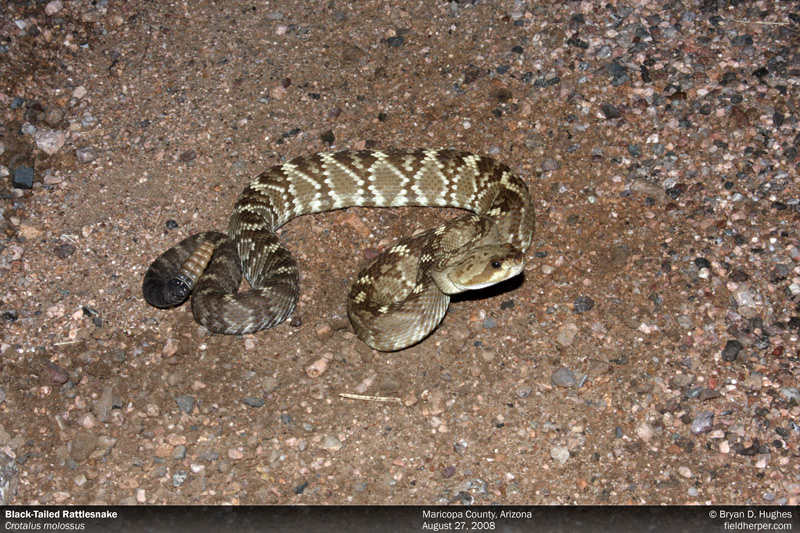
blacktail rattlesnake in Arizona
Tags: black-tailed, Blacktail, Crotalus molossus, desert phase, reptiles in arizona, Superstition Mountains
Posted in Field Herping | No Comments »
In late April and early May, I can’t even say how many times I’ve found a sidewinder while another snake is mid-capture. This one was a little different in that they were right on top of eachother. I’m unable to sight-sex this species, so I can’t say whether it was mating behavior or just coincidental sharing of a warm spot in the side-road gravel, but 2 snakes at once is definitely a cool find.

sidewinder in arizona
Tags: crotalus cerastes cercobombus, mating, rattlesnakes, reptiles in arizona, sidewinders
Posted in Behavior, Field Herping | No Comments »
Here’s another great example of the sneaky camouflage capabilities of one of the most commonly seen rattlesnakes in the sandy desertscrub, the Sonoran Sidewinder, Crotalus cerastes cercobombus. I found probably 200 of these guys in 2009 alone, and still stop for almost every one. Most of the pictures just go into my collection and never make it here, and I hope my interest in finding them never leaves me.

sidewinder rattlesnake
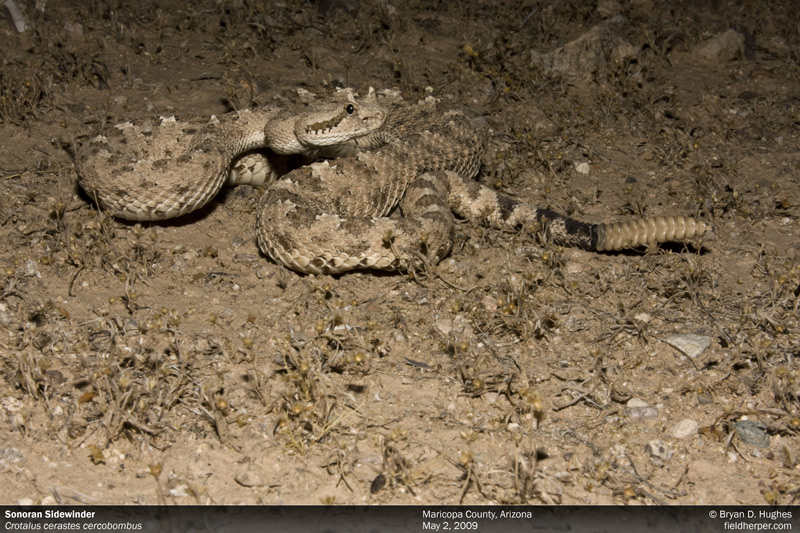
sidewinder from Arizona
Tags: crotalus cerastes cercobombus, rattlesnakes in arizona, reptiles
Posted in Field Herping | 1 Comment »
This isn’t a field photo, but still pretty cool. It’s my big all-black Arizona Black Rattlesnake, Crotalus cerberus, with white eyes as he prepares to shed his skin.
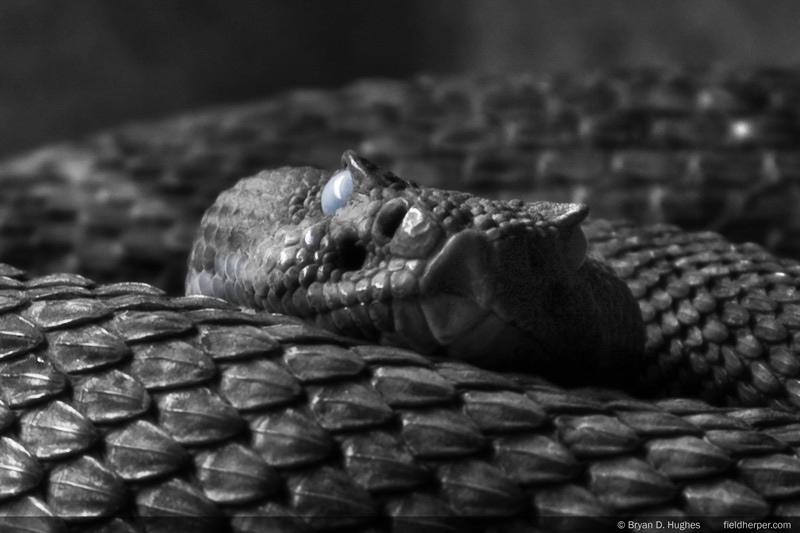
Zuul
‘
Tags: arizona, black-tailed rattlesnake, maricopa county, Photography, rattle snake, rattlesnake, rattlesnakes
Posted in Captive & Husbandry | No Comments »
Nothing particularly special about this female Western Diamondback Rattlesnake, Crotalus atrox, but I liked how clean the pattern is. Especially when compared to the dirty, speckled coloration of the atrox near my home, this one looks very nice.

Rattlesnake in Arizona
Tags: Crotalus atrox, rattlesnakes of arizona, Western Diamondback Rattlesnake
Posted in Field Herping | No Comments »
In 2009 I only saw 3 Desert Glossy Snakes, Arizona elegans eburnata. From a distance or at speed they look superficially like gophersnakes, but that long nose and almost rat-snake looking face makes for a good find. They’re really cool snakes, and I really wish I found more of them. Every one so far looks a little different.

Desert Glossy Snake in Arizona

A Snake in Arizona
Tags: arizona elegans eburnata, glossy snake, snakes of arizona
Posted in Field Herping | 1 Comment »
In 2009, for some reason, I found more black-necked garternskaes, Thamnophis cyrtopsis, than I’ve seen in all years previous combined. Most were in predictable locations, but a few were the last thing I thought I’d find, being several miles from the nearest reliable source of water.
Here are a few.

Gartersnake in Arizona

Blacknecked Gartersnake
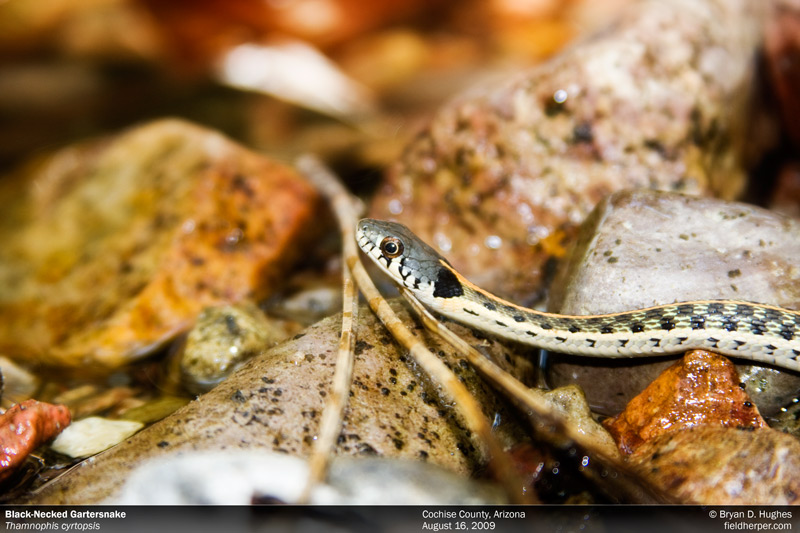
Thamnophis cyrtopsis
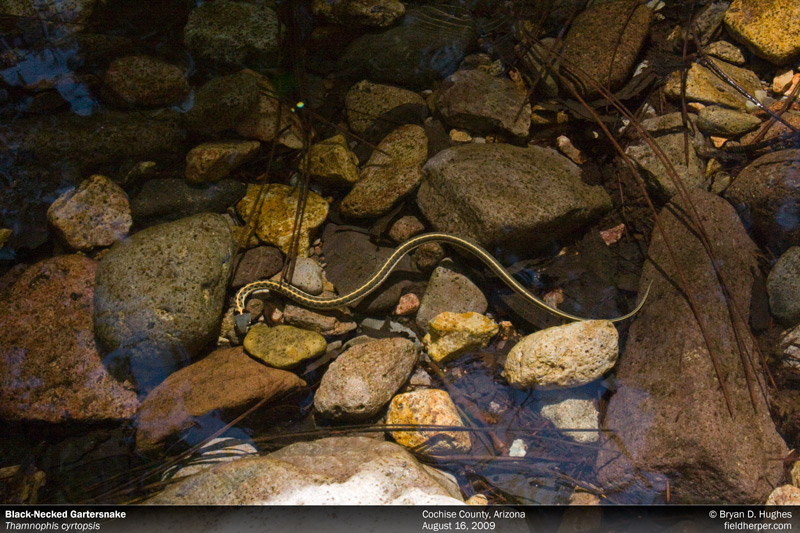
Garter Snake

Garter Snake in Arizona

There is a snake in there; can you see it?
Tags: black necked garter, garter snakes, Gartersnake, Thamnophis cyrtophis
Posted in Field Herping | No Comments »
Here are some pictures of a very common local snake, the long-nosed snake, Rhinocheilus lecontei. They have an enlarged snout (imagine that) that they use to dig out lizard eggs and sleeping whiptail lizards. These are often out when other snakes don’t want to be, for some reason, so seeing one of these as the first snake of a trip can mean it’s time to head home.

longnose snake

Rhinocheilus lecontei

looking for whiptails
Tags: long, longnose, rhinochilus lecontei
Posted in Field Trips | No Comments »
Here are a few of the Sonoran Gophersnakes, Pituophis catenifer affinis, I found during a few days of August in 2009. This is one of the most common snakes we have in Arizona, and I see them quite often. I have two in my collection as well, which were both called in to the AHA hotline as rattlesnakes. They’re pretty entertaining when you find them, as they put on a really good show most of the time. In fact, I’m still digging teeth out of my left index finger from one of them.

Gophersnake

Sneaky

I'm grass too!

Pituophis catenifer affinis

I bite you!

Pituophis

A big one

P-c-affinis-6-081609
Tags: gopher snake, Pituophis catenifer affinis, sonoran gophersnake
Posted in Field Herping | 1 Comment »
Here’s a neonate Chihuahuan nightsnake, Hypsiglena jani, a mildly venomous snake with eliptical pupils that is pretty common. A few years ago these were all just nightsnakes, but were split into three separate species. So … I guess this is a lifer for me, unless you count the probable jani I found near Payson awhile back. Whatever.

Chihuahuan nightsnake
Tags: chihuahuan nightsnake, hypsiglena jani
Posted in Field Herping | No Comments »
I was laying on my back in wet leaves high in the Chiricuahua mountains, hat over my eyes, taking a little break, when I heard some noise to my left. There was a Madrean Alligator Lizard, Elgaria kingii, cruising around looking for bugs. I used to catch similar lizards as a kid in Oregon, and I always like seeing one of these. I found quite a few in 2009, in fact, many more than in previous years.

Elgaria kingii
Tags: elgaria kingii, madrean alligator lizard
Posted in Field Herping | No Comments »
Here are a few of the many mojave rattlesnakes, Crotalus scutulatus, I found in a 3 day period in August, 2009. The species has an incredible amount of variation throughout its range, and these individuals are no exception. The 4 hour drive to this location shows quite a bit of difference between the light greenish scutulatus I see around Phoenix.
It’s also worth mentioning that the scutulatus from Cochise county have more toxic venom than they would elsewhere. I am not sure why this is, but I’m as careful as ever when handling these guys.

Neonate

Crotalus scutulatus

A pissy morning scutulatus

Mojave Rattlesnake

Another bad morning

Friendly
Tags: arizona, cochise county, Crotalus scutulatus, hidalgo county, mojave rattlesnake, neurotoxin, new mexico, venom
Posted in Field Herping | 4 Comments »


































